Evil Eye Symbol Meaning Spiritual: Protection and Power
The Evil Eye symbol, with roots in ancient Mediterranean, Middle Eastern, and South Asian civilizations, is steeped in spiritual significance as a protector against envy and malevolent forces. Believed to ward off negative energies and deflect harm, its use spans diverse cultures, each with unique interpretations and rituals.
This enduring symbol appears in various forms, such as blue glass beads and Hamsa hands, serving both aesthetic and protective roles. Its prominent presence highlights a universal concern for safeguarding well-being and spiritual health.
To explore the intricate cultural practices and modern adaptations of this symbol further, continue on.
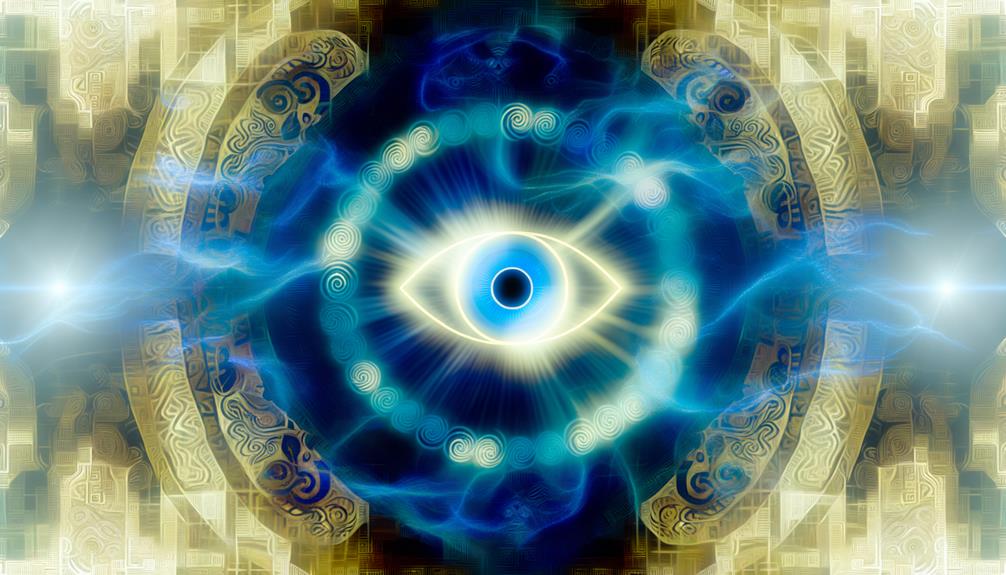
Evil Eye Symbol Meaning Spiritual: Protection, Energy Deflection, and Spiritual Awareness
| Aspect | Spiritual Meaning |
|---|---|
| Protection Against Harm | Shields against jealousy, curses, and malicious intentions |
| Energy Deflection | Reflects negative energy away from the wearer |
| Spiritual Vigilance | Encourages awareness of unseen spiritual influences |
| Intuition Enhancement | Boosts sensitivity to energy and emotional shifts |
| Universal Good Luck Charm | Seen as a talisman for peace, harmony, and positive outcomes |
| Ancient Spiritual Tool | Rooted in multiple cultures for centuries as a sacred symbol of safety |
Historical Origins
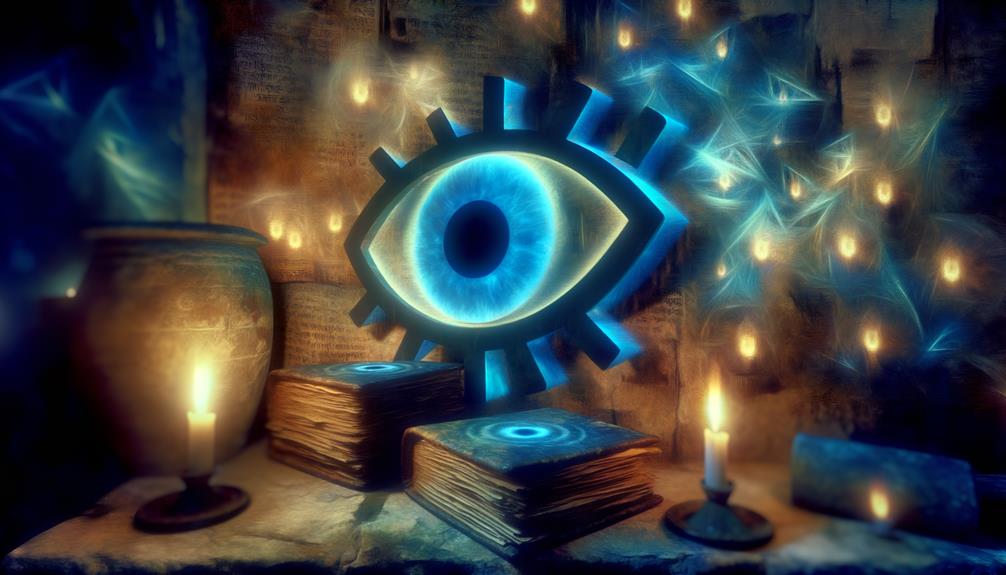
Tracing back to ancient civilizations, the concept of the evil eye has deep roots in the mythologies and cultural practices of societies across the Mediterranean, Middle East, and South Asia.
This belief system centers around the idea that certain envious or malevolent glances can inflict harm, misfortune, or ill health upon the recipient.
Historical evidence suggests that the fear of the evil eye was pervasive, influencing daily life, art, and religious rituals.
Ancient texts and artifacts, such as the amulets found in Mesopotamia or the protective charms in ancient Greece, underscore its significance.
Scholars suggest that this ubiquitous fear reflects a collective human concern with envy and the unseen forces that could disrupt wellbeing and harmony.
Cultural Significance
The Evil Eye holds profound cultural significance as an ancient protective amulet, believed to ward off malevolent forces.
Its interpretations vary across cultures, reflecting unique societal beliefs and practices, yet consistently emphasizing a universal human desire for protection and well-being.
Understanding these cross-cultural dimensions provides insight into the shared human experience of seeking safety and harmony in a world perceived as fraught with unseen dangers.
Ancient Protective Amulet
Throughout various ancient cultures, the Evil Eye amulet has been revered as a powerful protective symbol believed to ward off malevolent forces and ill intentions. This talisman, often depicted as a blue eye, has roots in civilizations such as the Egyptians, Greeks, and Romans.
It was commonly worn or placed in homes to shield individuals from envy and misfortune. The amulet’s enduring presence in these societies underscores its perceived efficacy and deep cultural resonance.
Crafted from materials like glass, metal, or clay, the Evil Eye served not only as a protective charm but also as a tangible representation of the human desire for safety and well-being. This ancient symbol continues to be cherished, reflecting its timeless significance.
Cross-Cultural Interpretations
Exploring the cultural significance of the Evil Eye reveals its profound impact across diverse societies, each attributing unique meanings and practices to this ancient symbol of protection.
In Mediterranean cultures, it is believed to ward off jealousy and envy, often represented by a blue eye amulet.
In Middle Eastern traditions, the Evil Eye or ‘Ayn al-Hasad’ is often countered with protective charms to prevent misfortune.
Meanwhile, in South Asia, it is common to use black kohl or other talismans to guard against malevolent gazes.
Key cultural interpretations include:
- Mediterranean: Blue eye amulets for protection.
- Middle Eastern: Charms against ‘Ayn al-Hasad’.
- South Asian: Black kohl as a protective measure.
This cross-cultural tapestry highlights the universal yet varied approaches to safeguarding against negative energies.
Symbolic Meaning
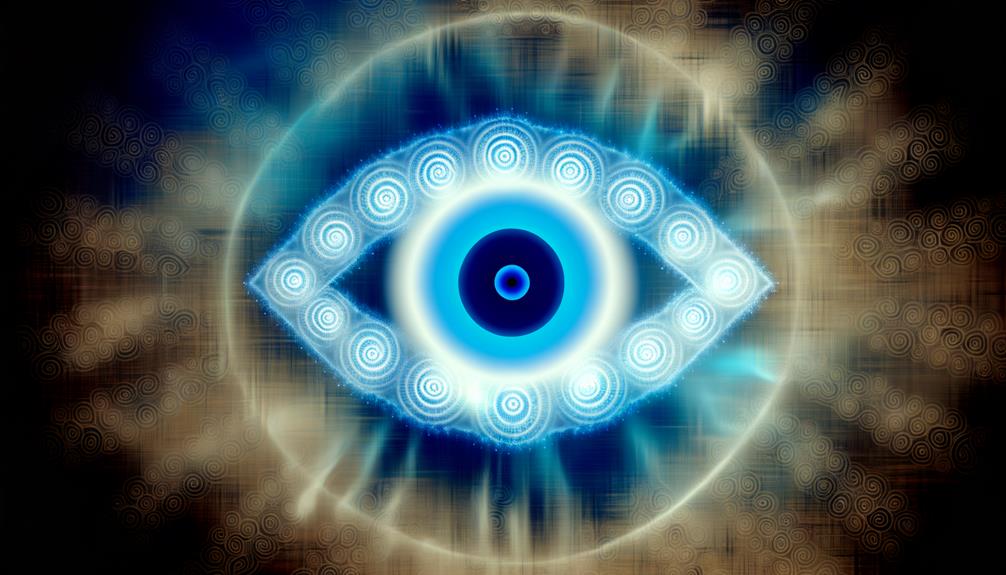
The symbolic meaning of the Evil Eye extends beyond mere superstition, representing a powerful amulet for protection against negativity.
Revered across various cultures around the globe, this symbol functions as a universal safeguard that transcends geographical and cultural boundaries.
Its enduring presence underscores a shared human concern for warding off malevolent forces and ensuring well-being.
Protection Against Negativity
As a powerful talisman, the evil eye symbol is believed to offer protection against malevolent forces and negative energies that may be directed towards an individual.
This protective quality is deeply rooted in its symbolic meaning, which encompasses the following aspects:
- Deflection of Harm: The evil eye is thought to ward off ill intentions and negative thoughts, reflecting them back to their source.
- Emotional Shielding: It provides a sense of psychological security, helping individuals to feel safeguarded from envy and malice.
- Spiritual Cleansing: The symbol is believed to purify one’s aura, ensuring that only positive energies surround the wearer.
Understanding these aspects allows one to appreciate the profound spiritual significance of the evil eye in protecting against negativity.
Cultural Significance Globally
Across various cultures, the evil eye symbol holds profound significance, embodying a universal belief in its power to protect against envy and misfortune.
In Mediterranean societies, it is a talisman, prominently displayed in homes and worn as jewelry to ward off malevolent gazes.
Middle Eastern traditions revere the symbol as a shield against ill will, often integrating it into everyday objects.
In South Asia, the evil eye, or ‘nazar,’ is deeply ingrained in cultural rituals, safeguarding individuals, especially children, from harm.
Latin American cultures incorporate it into spiritual practices, emphasizing its protective qualities.
This widespread reverence across diverse societies underscores a shared human concern about the impact of negative energy, highlighting the symbol’s enduring and cross-cultural resonance.
Varieties and Designs
Intricately woven into the fabric of diverse cultures, the varieties and designs of the Evil Eye symbol reveal a rich tapestry of historical evolution and artistic expression. This symbol manifests in myriad forms, reflecting regional styles and materials.
For instance, the Greek mati typically appears as a blue glass bead, while Middle Eastern designs often incorporate intricate patterns and precious metals.
Prominent varieties include:
- Blue Glass Bead – Largely seen in Mediterranean regions, symbolizing protection and tranquility.
- Hamsa Hand – Common in North African and Middle Eastern cultures, combining the Evil Eye with the protective hand motif.
- Red String Bracelets – Frequently used in Kabbalistic traditions to ward off malevolent forces.
Each design embodies a unique narrative, blending aesthetic beauty with profound spiritual significance.
Spiritual Protection
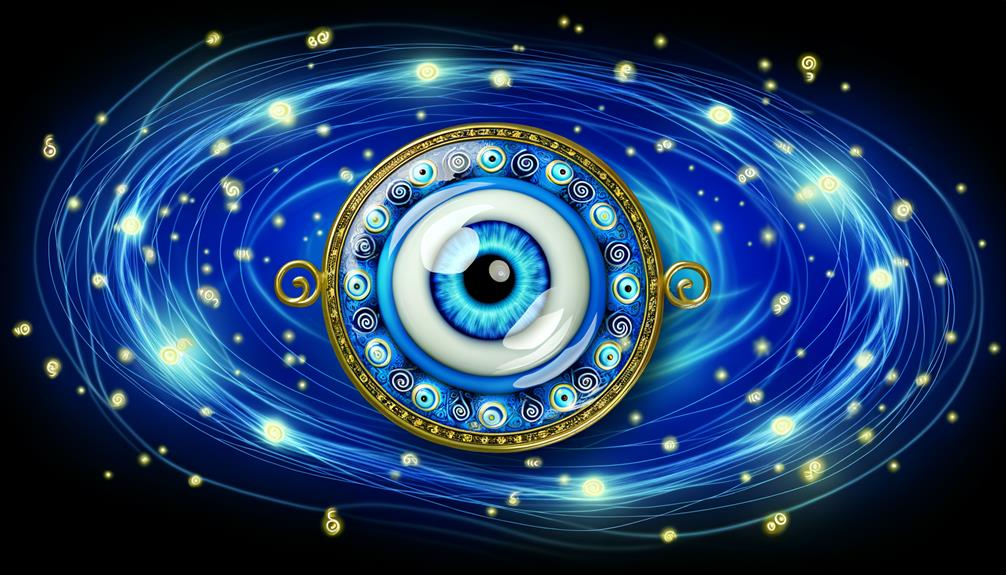
The Evil Eye symbol serves as a potent talisman in various cultures, revered for its ability to shield individuals from harmful energies and malevolent intentions. This emblem, often depicted as a glaring eye, functions as a barrier against envy, negativity, and ill will.
Through its vigilant gaze, it is believed to deflect intrusive forces, thereby safeguarding the bearer’s spiritual well-being. Historically, the symbol’s protective qualities have been harnessed in rituals and amulets to guarantee peace and harmony.
The Evil Eye is more than a mere object; it embodies a profound spiritual practice aimed at maintaining balance and guarding against unseen perils. Understanding its role offers valuable insight into the ways cultures navigate and mitigate spiritual threats. Various colors of the Evil Eye carry distinct meanings, each resonating with different spiritual energies. For instance, the pink evil eye spiritual meaning is often associated with love, compassion, and emotional healing, making it a powerful symbol for those seeking protection in their personal relationships. By embracing such variations, individuals can tailor their spiritual practices to reflect their specific intentions and desires. Across various traditions, the Evil Eye symbolizes not only the acknowledgment of negative intentions but also the resilience of communities in fostering spiritual well-being. Many cultures adopt rituals or items as forms of spiritual protection from the evil eye, reinforcing their beliefs and collective identity. This universal practice highlights the interconnectedness of individuals seeking safety in a world filled with invisible threats.
Modern Uses
In contemporary society, the Evil Eye symbol continues to be prevalent, seamlessly integrating into modern fashion, home decor, and digital spaces, while preserving its traditional role as a protective emblem.
This enduring symbol manifests in various forms, reflecting our collective desire for protection and aesthetic appeal.
Notable modern uses include:
- Fashion Accessories: Jewelry, such as necklaces, bracelets, and earrings, featuring the Evil Eye, are popular for their dual appeal of style and protection.
- Home Decor: Items like wall hangings, tiles, and ornaments often incorporate the Evil Eye, serving both decorative and spiritual functions.
- Digital Spaces: Emojis, social media graphics, and digital art frequently showcase the Evil Eye, blending ancient symbolism with contemporary communication tools.
These applications underscore the symbol’s timeless relevance.
Rituals and Practices
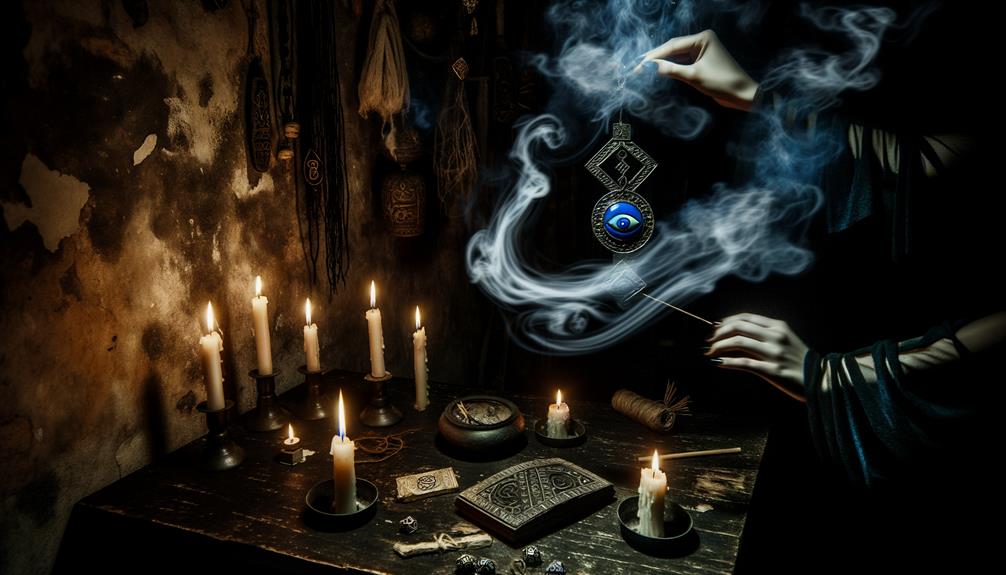
Rituals and practices surrounding the Evil Eye symbol are deeply rooted in cultural traditions, embodying a rich tapestry of beliefs and protective measures aimed at warding off malevolent forces.
Across various cultures, these practices often involve the use of amulets, talismans, and specific gestures to counteract the perceived threat of the Evil Eye. In Mediterranean countries, for instance, wearing a blue eye charm is common, while in the Middle East, the hamsa hand serves a similar protective function.
Additionally, rituals such as burning incense, reciting specific prayers or incantations, and even performing purification ceremonies are employed to cleanse individuals or spaces from negative energies.
These practices highlight a collective, enduring effort to seek spiritual safeguarding and harmony.
Misconceptions
Despite the widespread and diverse rituals aimed at countering the Evil Eye, numerous misconceptions persist about its origins, effects, and methods of protection.
First, some believe the Evil Eye is rooted solely in one culture, when in fact it spans various civilizations.
Second, the idea that only negative intentions can cast the Evil Eye overlooks the complex interplay of envy and unintentional harm.
Third, many assume that protection comes only through amulets, neglecting other spiritual practices and beliefs.
These misconceptions can obscure a deeper understanding of the Evil Eye’s historical and spiritual significance.
Addressing these points can foster a more nuanced appreciation of the profound cultural and spiritual dimensions surrounding this enduring symbol.
Global Influence
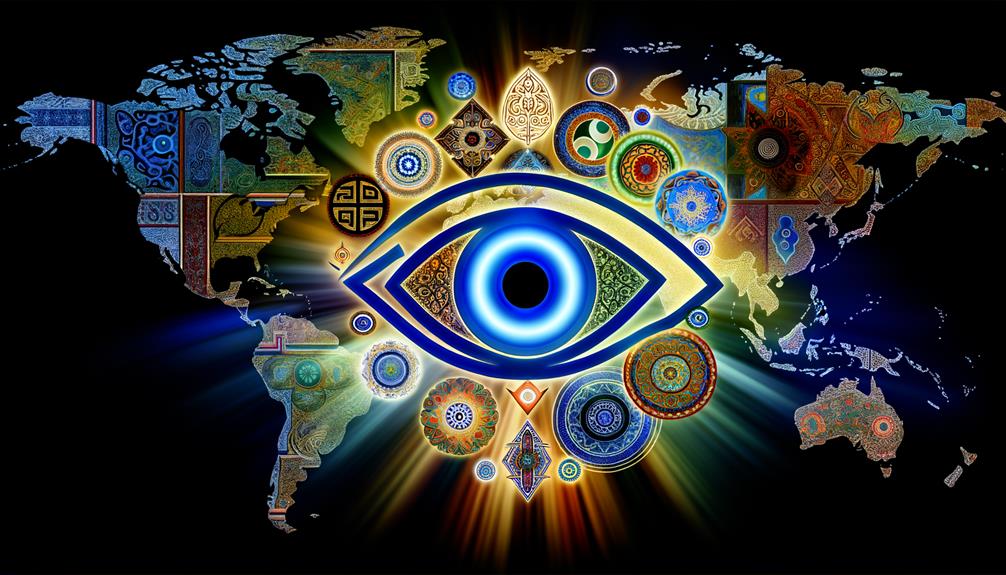
The pervasive reach of the Evil Eye across diverse cultures underscores its universal significance and the shared human experiences it represents.
From the Mediterranean basin to South Asia, the Evil Eye serves as a potent symbol of protection against envy and malevolence. Its widespread adoption highlights an intrinsic human desire to shield oneself from unseen negative forces.
In Turkey, Greece, and Italy, amulets known as ‘nazars‘ are common, while in Latin America, rituals like the ‘mal de ojo‘ cleanse the afflicted.
This global phenomenon reveals not only the cultural adaptability of spiritual symbols but also a collective acknowledgment of vulnerability.
The Evil Eye’s omnipresence reflects a profound psychological and social understanding that transcends geographical and cultural boundaries.
Conclusion
In summation, the evil eye symbol, steeped in historical significance and diverse cultural interpretations, serves as both a protective talisman and a spiritual emblem across the globe.
Its myriad designs and rituals underscore its enduring relevance and adaptability.
As a beacon of spiritual safeguarding, the evil eye transcends mere superstition, embodying a universal quest for protection and well-being.
Indeed, the symbol’s global resonance speaks to a shared human experience, bridging cultures and epochs.






